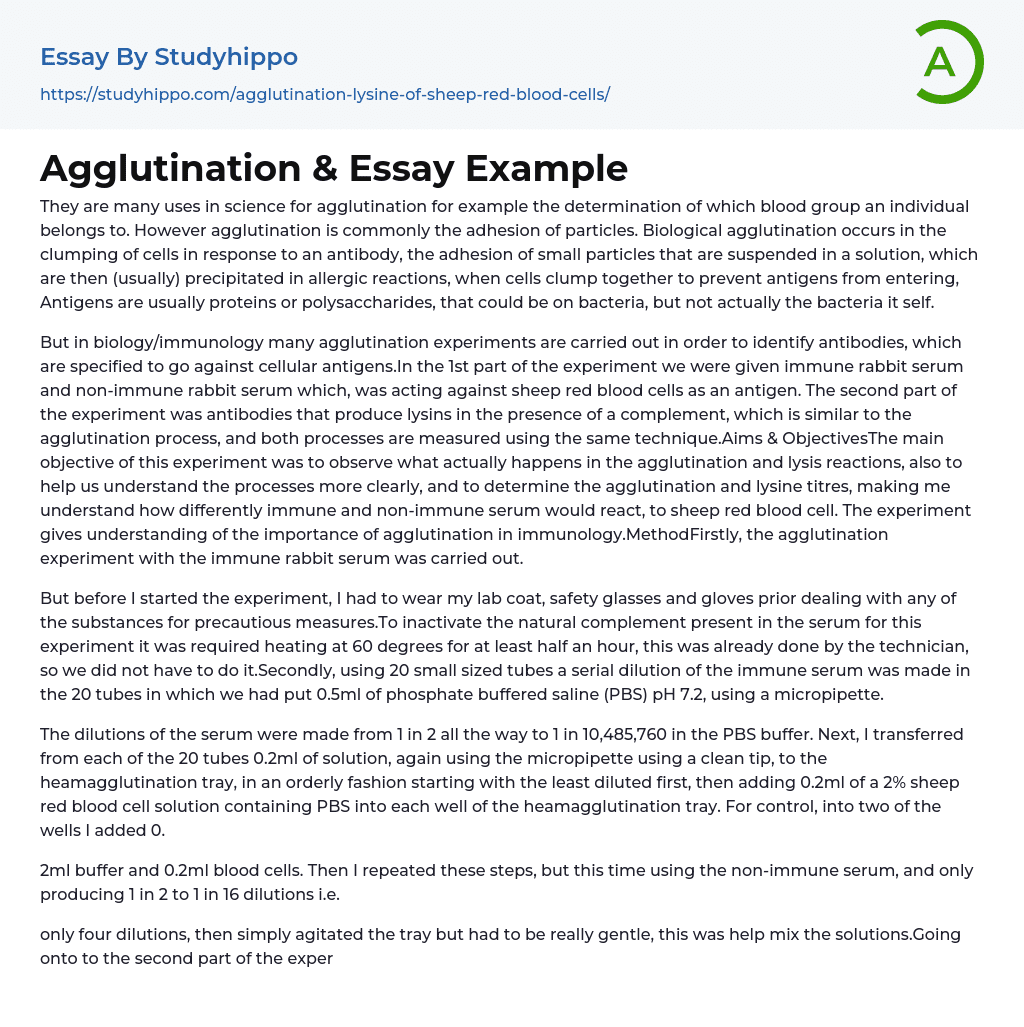Agglutination is employed in diverse scientific fields, including identifying blood groups of individuals. This process generally involves particles sticking to one another. In the realm of biology, agglutination arises when cells cluster because of an antibody response or when minute particles dispersed within a solution are precipitated; this phenomenon frequently occurs during allergic reactions. Cells clumping together also functions as a protective mechanism by blocking antigens from entering. Antigens, typically proteins or polysaccharides, can be found on bacteria but do not constitute the bacteria itself.
Agglutination experiments are crucial in biology and immunology as they help to identify antibodies which target cellular antigens. The experiment involves using immune and non-immune rabbit serum against sheep red blood cells acting as an antigen to observe agglutination reactions. Additionally, the same technique is utilized to measur
...e antibodies that produce lysins similar to the agglutination process. This allows for a clearer understanding of these processes and determination of agglutination and lysine titres. By comparing the reactions of immune and non-immune serum on sheep red blood cells, differences can be noted. Conducting the initial agglutination experiment with immune rabbit serum emphasizes the importance of this process in immunology.
Prior to commencing the experiment, precautionary steps were taken which involved donning a laboratory coat, safety glasses, and gloves. Furthermore, in order to avoid any disturbance caused by the inherent complement present in the serum, it was subjected to heating at 60 degrees Celsius for a minimum of half an hour by a technician. Subsequently, the immune serum underwent serial dilution with the aid of a micropipette into twenty tiny tubes that held 0.5ml phosphate buffered saline (PBS) pH 7.2.
Starting with a dilution o
1 in 2 and going up to 1 in 10,485,760 in the PBS buffer, I made dilutions of the serum. To transfer the solution, I used a micropipette with a clean tip and added 0.2ml from each of the 20 tubes to the heamagglutination tray. I added the solutions in an orderly fashion starting with the least diluted solution. Next, I added 0.2ml of a 2% sheep red blood cell solution containing PBS to each well of the heamagglutination tray. As control, I added nothing to two of the wells.
The procedure involved combining 2ml of buffer with 0.2ml of blood cells. This process was performed twice, with the second iteration utilizing non-immune serum. The resulting dilutions ranged from 1 in 2 to 1 in 16.
The initial stage of the experiment involved using only four dilutions and gently agitating the tray to mix solutions. The second part, which was the lysine titration section, followed the same process as the agglutination experiment. However, in this stage, after combining PBS, diluted immune rabbit serum, and sheep red blood cells in the heamagglutination tray, 0.2ml of 1 in 30 diluted guinea pig complement were added to each well. The same procedure was used for adding guinea pig complement to non-immune serum during the non-immune serum agglutination process.
There were two control wells employed in the experiment. The initial well held 0.4ml of PBS and 0.2ml of sheep red blood cells, while the second contained 0.2ml of complement, 0.2ml of PBS, and 0.2ml of sheep red blood cells.
After being left at room temperature for 3 hours, the heamagglutination tray was expected to produce reactions. However, my results were not
obtained until the following day when I left the tray overnight at a temperature of 4 degrees Celsius. This slower process allowed for easy observation of agglutination. Agglutination could be determined by observing blood cells spreading around the wells in case of agglutination and settling at the bottom in case of no agglutination. The results from wells containing PBS, immune rabbit serum and sheep red blood cells showed agglutination in the first four wells which indicated an end point titre of 1 in 16 dilutions for agglutination of immune rabbit serum against sheep red blood cells.
Observation of wells 5 to 20 revealed formation of a tight button of blood cells at the bottom of each well. This indicated absence of agglutination due to high dilution. Control wells that contained only PBS and sheep red blood cells did not show expected signs of agglutination, indicating serum non-immunity to blood cells. Results of lysis reactions showed greater immune effect against sheep red blood cells extracted from the same sample as used in agglutination process. However, lysis reactions occurred only until the first 6 wells and showed greater spread in comparison to agglutination reactions. The endpoint titre was 1 in 64 dilutions, observed in the last well where lysis occurred, i.e., well 6.
Between wells 7 and 20, no lysis took place because the sheep red blood cells had formed a solid button at the bottom of the wells. The control wells also showed no lysis because they did not contain any serum. The last four wells contained non-immune serum, which was confirmed as non-immune as there were no reactions in any of the wells.
- Microbiology essays
- Bacteria essays
- Cell essays
- Enzyme essays
- Photosynthesis essays
- Plant essays
- Natural Selection essays
- Protein essays
- Viruses essays
- Cell Membrane essays
- Human essays
- Stem Cell essays
- Breeding essays
- Biotechnology essays
- Cystic Fibrosis essays
- Tree essays
- Seed essays
- Coronavirus essays
- Zika Virus essays
- Organic Chemistry essays
- Acid essays
- Calcium essays
- Chemical Bond essays
- Chemical Reaction essays
- Chromatography essays
- Ethanol essays
- Hydrogen essays
- Periodic Table essays
- Titration essays
- Chemical reactions essays
- Osmosis essays
- Carbohydrate essays
- Carbon essays
- Ph essays
- Diffusion essays
- Copper essays
- Salt essays
- Concentration essays
- Sodium essays
- Distillation essays
- Amylase essays
- Magnesium essays
- Acid Rain essays
- Agriculture essays
- Albert einstein essays
- Animals essays
- Archaeology essays
- Bear essays
- Biology essays
- Birds essays




